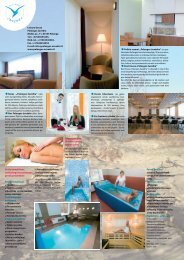Jie neleidžia nutilti gerai muzikai - Business and Exhibitions
Jie neleidžia nutilti gerai muzikai - Business and Exhibitions
Jie neleidžia nutilti gerai muzikai - Business and Exhibitions
You also want an ePaper? Increase the reach of your titles
YUMPU automatically turns print PDFs into web optimized ePapers that Google loves.
FORESTRY<br />
Pavasarinės inkilų kėlimo akcijos metu<br />
During the spring action of lifting nesting-boxes<br />
after several hours all dirty. as it happened, he had tried<br />
to take the most effective photo of a stork then. <strong>and</strong> you<br />
should have seen that look on our seed buyer’s face, when<br />
the same white stork perched, we may say, within a reach<br />
of a h<strong>and</strong>, under our noses, on the road.”<br />
Yet birds, especially the cranes, are particularly keen of<br />
Novaraistis ornithological reserve.<br />
some time ago, Novaraistis together with the pineries,<br />
growing at the approaches, typical to upl<strong>and</strong> moor, used to<br />
cover a 1000-hectare area. This upl<strong>and</strong> moor has formed<br />
from an overgrown lake, because it was only fed from<br />
the streams of surface waters, none of the rivers refilled<br />
it with water, <strong>and</strong> only Nova outflowed from it. rich<br />
flora, especially the peat-moss, has squeezed the lake,<br />
leaving only one hectare of open water area there, which<br />
is now being called “the Eye” by the locals. Naturally,<br />
Novaraistis was very lively in all aspects. the lake used<br />
to be embellished by the heaths, marsh teas, blueberries,<br />
rich cover of peat-moss, fecund cranberries, which lured<br />
blackcocks, making all Novaraistis a one big gogglybubbly<br />
place. “there used to be loads of cranes here too,”<br />
the Šakiai foresters write, remembering the time not that<br />
distant. at all times, wolves have lived <strong>and</strong> reproduced<br />
here, elks liked to drop in <strong>and</strong> wild boars used to live at the<br />
approaches. there were plenty of whipsnakes, vipers –<br />
adder snakes – <strong>and</strong> blindworms; <strong>and</strong> many living beings<br />
as well: interesting animals <strong>and</strong> insects. still the moor has<br />
destroyed everything. Yet the very peat appeared to be not<br />
much worth either. Novaraistis peatbog was left str<strong>and</strong>ed<br />
in 1990. Šakiai Forest Directorate has without prejudice to<br />
working hours, human <strong>and</strong> financial resources taken all the<br />
peakbog on their shoulders then. they have reconstructed<br />
Lithuanian Economic Review<br />
BUSINESS&EXHIBITIONS<br />
the dike of Nova river, made lifts on the motor ways,<br />
affluented the north part of Novaraistis, which resulted<br />
in the languishing of overgrowth of growing birches, the<br />
development of open areas for birds. at the approaches of<br />
the peatbog the conditions for the growth of upl<strong>and</strong> plants<br />
have emerged, fish have appeared in the affluent areas;<br />
the foresters have built a turret for bird observation <strong>and</strong><br />
have fixed the marsh entrance road. today, 33 types of<br />
birds, registered in the list of the EU protected birds, are<br />
tracked in Novaraistis; during the migration in autumn,<br />
over 3 thous<strong>and</strong> cranes fly over to Novaraistis. there is<br />
even a film created about Novaraistis, titled “raised for<br />
new life”. The author of this film is Vytautas Jankevičius,<br />
who was awarded a Petras Abukevičius prize.<br />
<strong>and</strong> so today Novaraistis does not cause any big trouble<br />
to the foresters. Yet the forest supervisor sigitas tamošaitis<br />
is worried about another oncoming project; that the forests<br />
surrounding the pearl of l<strong>and</strong>scape <strong>and</strong> architecture – the<br />
gelgaudiškis manor <strong>and</strong> park – will be poorly supervised<br />
or completely ab<strong>and</strong>oned. to be exact, after drafting a<br />
detailed plan, the state forest territory, adjoining the manor,<br />
will be transferred to the municipalities or the county. the<br />
supervisor has well-reasoned doubts that the new owners<br />
may lack the specialists, human resources, comprehension<br />
or finances for its management. the manor is really<br />
impressive – it covers a territory of 112.5 hectares along<br />
with the forest park; it is also of a mixed plan: with particular<br />
geometrical elements, <strong>and</strong> natural crossings to the forests<br />
stretching within the Nemunas valley. the foresters of the<br />
directorate take care of the cognitive path thoroughly <strong>and</strong><br />
professionally. here one can not only get acquainted with<br />
the history, but also to see rare trees – Black pine, Eastern<br />
White pine, red oak, <strong>and</strong> European Beech. only a few<br />
weeks ago, the highest spruce of suvalkija (42.5 meters)<br />
stretched its crown to the sky. Unfortunately, it has already<br />
been well-rotten <strong>and</strong> endangered the locals <strong>and</strong> tourists,<br />
thus the foresters have cut it down. Besides, the cut spruce<br />
has not been used as firewood. The cut-offs are now either<br />
exhibited in the VĮ Šakiai Forest Directorate Museum-<br />
Informational Centre, established by the Lekėčiai Forestry,<br />
or transferred to educational institutions. scientific <strong>and</strong><br />
biometric researches of the gr<strong>and</strong> tree are going to take<br />
place there. thus we can openly say that despite the fact<br />
that the spruce was cut down, it will still develop the<br />
scientific <strong>and</strong> cognitive functions, just like the rest of the<br />
exhibits of the museum-informational centre, the total of<br />
over a thous<strong>and</strong> pieces.<br />
the most of the exhibits have been gathered in the<br />
Lekėčiai neighbourhood; <strong>and</strong> there are no animal or<br />
taxidermied animal purposely killed for that reason. thus<br />
it was only 20 th of March, 2010 that a diorama of cranes,<br />
donated to the museum by a well-known taxidermist<br />
Kęstutis Bybartas, was finally opened.<br />
the memory is also saved within live trees. With regard<br />
to the state programme of oakery restoration, the foresters<br />
of Šakiai have organized the planting of 30 hectares of<br />
oaks. in the Šakiai commemorative oakery there are<br />
loads of nominal oaks, paying respect to the long-serving<br />
foresters.<br />
35





